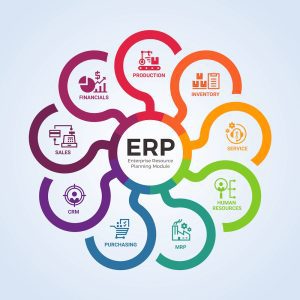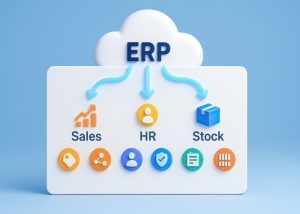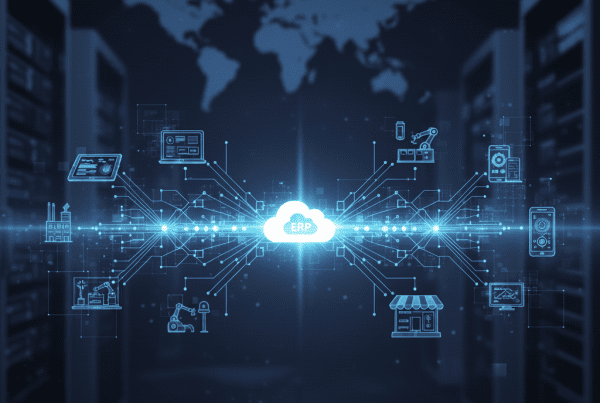Picture this: your sales team just closed a major deal, but the inventory team has no idea they need to reorder stock. Accounting is working with last week’s numbers, and HR is still tracking hours across three different spreadsheets. Sound familiar?
If your business feels like a collection of isolated departments speaking different languages, you are not alone. Many organizations reach a point where the systems they started with begin to hold them back. Disconnected tools create gaps, miscommunication, and slowdowns that affect every part of the business.
Enterprise Resource Planning (ERP) offers a different approach. It brings core business functions into a single, integrated system, making it easier to share information, improve visibility, and streamline operations. Whether you are a growing startup or a more established enterprise, understanding ERP could be the key to running your business more smoothly. This blog explores what ERP is, how it works, and why it has become a necessary tool for modern businesses.
What Is ERP?
Enterprise Resource Planning, or ERP, is software designed to help organizations manage and integrate their most important business processes. It creates a central hub where information from various departments can be stored, accessed, and used to make informed decisions.
In traditional business setups, each department often operates with its own systems. The accounting team might use one platform for bookkeeping, the human resources department another for managing employee records, and the operations team yet another for overseeing inventory. While these individual systems may function well on their own, they create silos that make it difficult for information to flow freely across the company.
ERP solves this challenge by combining these functions into a single system. This means data entered in one area, such as a sales order, can automatically update inventory levels, trigger procurement processes, and adjust financial projections without manual data transfers.
Although ERP is often associated with large enterprises, it is just as useful for small and mid-sized businesses. Modern ERP systems are scalable, meaning they can grow alongside the business, adapting to changing needs and industry demands.
Core Functions of an ERP System
ERP systems are designed to manage a wide range of business activities. While the exact features can vary depending on the platform and industry, most ERP systems focus on these core areas:
Finance and Accounting
One of the most important functions of an ERP system is financial management. ERP software can handle everything from budgeting and forecasting to expense tracking and reporting. It gives finance teams an accurate, real-time view of a company’s financial health. Instead of working with outdated spreadsheets or waiting for end-of-month reports, managers can quickly access live data to make informed decisions.
Human Resources
Human resources teams rely on ERP systems to manage employee data, track attendance, process payroll, and support recruitment. An ERP system can store records such as performance reviews, training history, and benefits information. This helps HR teams stay organized and ensures compliance with employment regulations.
Inventory and Supply Chain
For businesses that sell products, keeping track of inventory is critical. ERP systems help by monitoring stock levels, managing purchase orders, and coordinating with suppliers. This function reduces the risk of running out of products or overstocking items that are not selling. Many ERP platforms also support advanced features like demand forecasting, which helps companies plan more accurately for the future.
Customer Relationship Management
Some ERP systems include customer relationship management tools, allowing businesses to track leads, manage customer accounts, and analyze sales trends. When this data lives in the same system as other business functions, sales and service teams can respond faster and with better context. For example, they can view a customer’s order history, check on shipments, or resolve issues without switching between systems or requesting information from other departments.
Operations and Manufacturing
ERP systems are especially useful for businesses involved in manufacturing. They support production planning, scheduling, and workflow management, helping teams stay organized and focused. These tools make it easier to use materials, labor, and equipment in a way that avoids waste and keeps work moving. By monitoring production data in real time, managers can spot delays, adjust schedules, and keep projects on track.

How Does ERP Work?
An ERP system works by centralizing data from multiple departments into a single, shared database. This setup eliminates the need for duplicate data entry and reduces the chance of human error.
Here is how it works in practice:
When a sales team member enters a new customer order, the information is instantly available to other departments. The inventory team can see the impact on stock levels, the procurement team can place an order for additional supplies if needed, and the finance department can adjust revenue projections. This real-time data sharing improves coordination across departments and accelerates decision-making.
ERP systems also use automation to reduce manual tasks. For example, generating invoices, reconciling accounts, or creating performance reports can be done automatically. This not only saves time but also ensures greater accuracy.
Modern ERP solutions are available in two main forms: on-premise and cloud-based. On-premise systems are installed locally on a company’s servers, giving businesses full control over the software and its data. Cloud-based ERP systems, on the other hand, are hosted online, allowing employees to access them from any location with an internet connection. This flexibility has made cloud ERP an increasingly popular choice, especially for companies with remote or hybrid workforces.

Benefits of Using ERP
ERP systems provide a wide range of advantages for businesses that adopt them.
Increased Efficiency
By combining multiple business processes into one system, ERP reduces the need for duplicate data entry and minimizes manual tasks. Employees can spend less time on repetitive administrative work and more time on high-value activities that drive growth.
Better Decision-Making
Real-time access to data helps leaders make informed decisions quickly. Whether it’s analyzing sales trends, monitoring inventory levels, or reviewing financial performance, managers can get the insights they need without waiting for reports to be compiled.
Improved Collaboration
When all departments use the same system, communication becomes clearer and more reliable. Teams can share information without delays, avoid miscommunication caused by outdated or missing data, and stay aligned on shared goals.
Greater Visibility
ERP gives managers a full view of what is happening across the company, from sales and inventory to finance and HR. With this level of visibility, it is easier to spot issues early, monitor performance, and track progress toward business goals.
Scalability
ERP systems are designed to grow with a business. As a company expands, it can add new features, users, or modules without needing to replace the entire system. This makes ERP a long-term solution for businesses aiming for sustainable growth.
Types of ERP Systems
When considering ERP, it is important to understand the different types available. Each option varies in how it is deployed, managed, and scaled. Some systems are better suited for small businesses with limited IT resources, while others are designed for large enterprises with complex requirements. Knowing the differences helps you choose a system that fits your organization’s size, goals, and internal capabilities.
On-Premise ERP
This type of ERP is installed directly on a company’s servers. It provides greater control over data and system configurations but requires significant upfront investment and ongoing maintenance.
Cloud-Based ERP
Hosted online, cloud ERP systems offer flexibility and can be accessed from anywhere. They usually involve a subscription model, making them more cost-effective for smaller businesses. Updates and maintenance are handled by the provider, reducing the burden on internal IT teams.
Hybrid ERP
Some companies choose a combination of on-premise and cloud solutions. This approach allows them to keep certain sensitive data in-house while benefiting from the flexibility of the cloud for other functions.
Is ERP Right for Your Business?
Not every company needs an ERP system, but for many, it can be transformative. Businesses experiencing rapid growth, dealing with complex supply chains, or struggling with disconnected software platforms may find that ERP offers the structure and integration they need.
Before adopting ERP, consider factors like your budget, the size of your organization, and your industry requirements. It is also helpful to outline the specific challenges you want ERP to solve. This ensures that the system you choose will deliver meaningful results.
A Smarter Way to Manage Your Business
ERP brings together the many moving parts of a business into one coordinated system. By centralizing data, streamlining workflows, and providing real-time insights, it helps companies reduce delays, avoid duplicate work, and respond more quickly to changing needs. Whether you are managing finances, overseeing production, or supporting customers, ERP gives you the tools to keep operations running smoothly and make informed decisions.
As businesses navigate a more competitive and fast-moving environment, ERP has become more than just a software solution. It’s a practical way to bring structure and visibility to the systems that keep your business running: from tracking inventory and handling orders to managing cash flow and supporting customers. When used well, ERP helps teams stay focused, connected, and better prepared for growth.
About Atlantic, Tomorrow’s Office
Atlantic is an award-winning office technology and IT solutions company providing Imaging Products, IT Support, Document Management, Cybersecurity and Managed Services to small and large companies in the New York City metropolitan area, and the Greater Philadelphia and Delaware Valley.
For the latest industry trends and technology insights visit ATO’s main Blog page.





